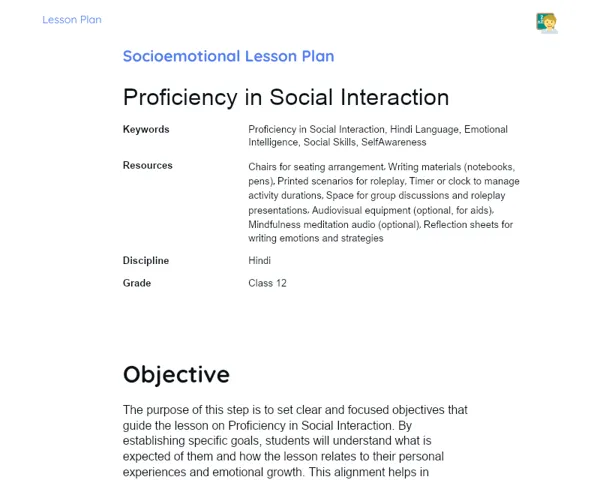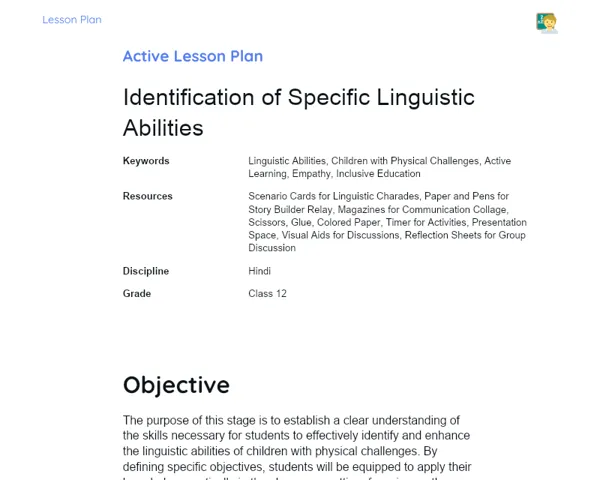Lesson Plan | Active Methodology | Characteristics of Essays and Articles
| Keywords | Essays, Articles, Differences in Writing, Active Learning, Critical Thinking, Audience Engagement, Creative Writing, Debate, Collaboration, Communication Skills, Structure and Style, Practical Application |
| Necessary Materials | Colored paper, Markers, Stationery, Projector for presentations, Printed handouts explaining essay and article characteristics, Whiteboard and markers for group discussions, Timer for activity duration management, Voting slips for audience feedback |
Premises: This Active Lesson Plan assumes: a 100-minute class duration, prior student study both with the Book and the beginning of Project development, and that only one activity (among the three suggested) will be chosen to be carried out during the class, as each activity is designed to take up a large part of the available time.
Objectives
Duration: (10 - 15 minutes)
This stage aims to establish clear goals for the students, focusing on the skills necessary to differentiate between essays and articles. By outlining these objectives, students will understand what is expected of them, guiding their learning process. This clarity ensures that students are aware of the competencies they need to develop, which will enhance their engagement in the subsequent activities.
Main Objectives:
1. Students will identify and articulate the key differences in structure and style between essays and articles.
2. Students will demonstrate the ability to express their arguments clearly and effectively in the format of both essays and articles.
Side Objectives:
- Students will learn the importance of audience and purpose in choosing the correct format for written communication.
- Students will develop critical thinking skills by analysing and discussing examples of essays and articles.
Introduction
Duration: (10 - 15 minutes)
This stage aims to engage students by connecting their previous knowledge with practical applications. By presenting problem situations and real-life contextualization, students will be encouraged to critically think about the differences between essays and articles. This context will motivate them to participate actively and thoughtfully in the lesson, fostering a deeper understanding of the importance of writing styles in effective communication.
Problem-Based Situation
1. Imagine a class debate where some students argue passionately about a social issue using an article format, while others express their views with an essay-style argument. How would the different formats affect the clarity and impact of their arguments?
2. Consider a situation where a student is tasked with writing for the school magazine. They need to decide whether to write an article that informs and engages the readers or an essay that reflects their personal thoughts and insights on a particular topic. What factors would influence their choice?
Contextualization
In today's digital age, the ability to express thoughts clearly and effectively is paramount. Students often interact with various forms of written communication, from blogs to opinion pieces. Understanding the nuances between essays and articles not only enhances their academic skills but also prepares them for real-world scenarios where clear communication is essential, whether they're crafting an argumentative piece for a debate or writing an engaging article for the local newspaper. For instance, a student who writes an article about environmental conservation may need to focus more on active voice and engaging hooks, while an essay on the same topic might delve deeper into personal reflections and structured arguments.
Development
Duration: (70 - 80 minutes)
This stage of the lesson plan aims to engage students in hands-on activities that encourage active learning and collaboration. By participating in creative and interactive exercises, students will deepen their understanding of the differences between essays and articles, allowing them to apply theoretical knowledge in practical contexts. This approach fosters critical thinking, teamwork, and effective communication, equipping students with essential skills for both academic and real-world writing.
Activity Suggestions
It is recommended that only one of the suggested activities be carried out
Activity 1 - ESSAY vs. ARTICLE: The Great Showdown!
> Duration: (60 - 70 minutes)
- Objective: To demonstrate the differences in structure and style between essays and articles while engaging in an interactive and lively discussion that enhances presentation skills.
- Description: In this theatrical activity, students will participate in a 'debate-style' presentation where they will transform traditional essay arguments into engaging article formats. Each group will take a provocative statement related to current social issues, such as 'Education should be free for all' or 'Social media influences our decisions'. Students will split into two teams—one will prepare an argumentative essay while the other will craft an article on the same topic. They will then present their arguments to the class, with a focus on engaging styles, methods of persuasion, and clarity. The audience will vote on which format most effectively communicated the message.
- Instructions:
-
- Divide the class into groups of up to 5 students.
-
- Assign each group a provocative statement related to a social issue.
-
- One half of the group will develop an essay using a structured argument format.
-
- The other half of the group will write an article that is engaging and informative.
-
- Each group will spend 20 minutes preparing their presentations.
-
- Groups will present their arguments to the class for 10 minutes each.
-
- After the presentations, hold a class discussion and vote on which format was more effective.
Activity 2 - Crafting a Compelling Comparison!
> Duration: (60 - 70 minutes)
- Objective: To reinforce the key characteristics of essays and articles through collaborative creative expression, enhancing understanding through visual aids.
- Description: Students will engage in a creative writing challenge where they will create a dual-page handout comparing essays and articles. One side of the handout will focus on the key characteristics of essays, while the other side will delve into the features of articles. Students will use drawings, bullet points, and examples to make their comparison visually appealing and informative.
- Instructions:
-
- Divide the class into teams of 5.
-
- Provide each team with materials like colored paper, markers, and stationery.
-
- Allocate 30 minutes for groups to create a visually engaging comparison handout.
-
- Each team will then present their comparison to the class in 5-minute segments.
-
- Display the final handouts around the classroom for future reference.
Activity 3 - The Writing Relay Challenge!
> Duration: (60 - 70 minutes)
- Objective: To actively engage students in understanding the characteristics of essays and articles through a collaborative and competitive writing exercise.
- Description: In this fast-paced relay race, each group will be given a topic to write about. The catch is that each student must contribute a sentence that fits the style of either an essay or an article. The ideas will be mixed up, and students will need to work together to assemble a coherent piece by the end of the relay. This fun and dynamic activity will encourage students to think on their feet and understand the structural requirements of each format.
- Instructions:
-
- Divide the class into groups of 5.
-
- Assign each group a unique topic related to a social issue.
-
- Each student in the group will write a sentence in either essay or article style, passing the paper around the group.
-
- After 10 minutes, students will present their creations, explaining why they chose their specific styles.
-
- The class can vote on the most coherent piece that clearly reflects the characteristics of essays and articles.
Feedback
Duration: (10 - 15 minutes)
The purpose of this feedback stage is to facilitate a comprehensive discussion that encourages students to reflect on their experiences during the activities. By sharing insights and conclusions, students will solidify their understanding of the characteristics of essays and articles. This collaborative reflection not only enhances their critical thinking skills but also promotes peer learning as they engage in dialogue about their challenges and successes. The discussion allows students to articulate their thoughts clearly, fostering an environment of shared knowledge and reinforcing the importance of effective writing styles.
Group Discussion
Thank you, everyone, for your fantastic presentations! Now, let's take some time to share our insights. I'd like each group to discuss what they learned about the differences between essays and articles through your activities. Consider how the various styles of writing impacted the way you formulated your arguments. Let’s hear from each group about the challenges faced and the strategies that made your presentations compelling.
Key Questions
1. What were the main differences you observed in the audience's engagement with essays versus articles?
2. How did the format influence the clarity of your arguments in the debates?
3. Which writing style do you feel is more effective for the topics discussed, and why?
Conclusion
Duration: (10 - 15 minutes)
The purpose of this conclusion stage is to consolidate students’ learning by summarising key points from the lesson, highlighting the connections between theory and practice, and emphasising the practical relevance of the topic. Through this reflection, students will better appreciate the importance of mastering different writing styles, preparing them for both academic challenges and real-world interactions.
Summary
In this lesson, students explored the key characteristics of essays and articles, understanding the structural and stylistic differences between the two forms of writing. They engaged in activities that allowed them to transform argumentative essays into engaging articles, thereby recognising the unique approaches required for each format. Through debates, creative handouts, and writing relays, students gained practical insights into how to effectively communicate their arguments and ideas, enhancing their writing skills in the process.
Theory Connection
The lesson effectively connected theory to practice by allowing students to apply their prior knowledge of essays and articles in a real-world context. The hands-on activities demonstrated the theoretical frameworks discussed, making the learning experience tangible and relevant. By participating in debates and creating writing pieces, students bridged the gap between understanding writing styles and executing them in their own work, reinforcing the importance of effective communication in various scenarios.
Closing
Understanding the differences between essays and articles is crucial for students as they prepare for higher studies and future career paths. The ability to choose the appropriate format for different audiences and purposes will enhance their written communication skills, essential in today's world of social media, professional writing, and academic discourse. By mastering these formats, students equip themselves with the tools necessary for successful engagement in diverse communicative contexts.



